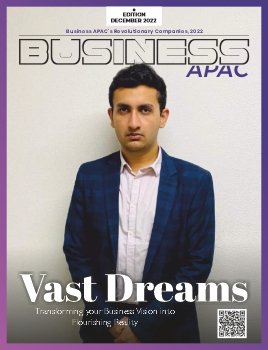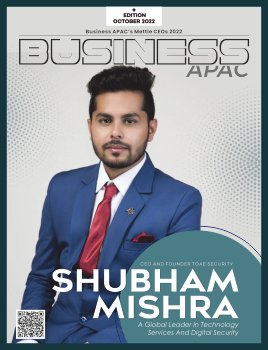The APAC region is experiencing a rapid rise in digital healthcare. The increased mobile connectivity across the region has given rise to technologies like cognitive intelligence, virtual reality, augmented reality, and voice interfaces; these technologies are being quickly adopted and telehealth is emerging as a viable means to democratize healthcare.
Dr. Nadine Hachach-Haram FRCS (Plast), BEM, is Consultant Plastic Surgeon and Head of Clinical Innovation at Guy’s and St. Thomas’ NHS Foundation Trust. She is someone who has witnessed and played a proactive role, in the telehealth boom, which has been recently hastened by COVID-19. In 2015, the clinical entrepreneur drew on her surgical experiences and her passion for innovation and education, to create Proximie; a technology platform on a mission to save lives by sharing the world’s best clinical practice.
Proximie: Extending the Virtual Reach of Clinical Expertise
“Imagine a world where every surgeon had all the expertise and information available in real-time so they could deliver the best surgical care, for every patient, every single time?” Dr. Nadine explains. “As a training surgeon I grew increasingly frustrated with the widening inequity in care and I wanted to see if we could create a solution, using technology, that could empower surgeons to virtually and practically interact with each other from anywhere in the world, in order to share expertise at a scale that could help to save lives. This variation wasn’t only witnessed in the developing world where I had dedicated my time to global surgical initiatives, but it was also witnessed in the developed world across established health systems.”
Proximie is a technology platform that uses a combination of machine learning, artificial intelligence, and augmented reality to empower surgeons and clinicians to virtually and practically interact with each other from anywhere in the world. Before, during, and after surgery. Using augmented reality, healthcare practitioners can remotely interact in a procedure or assessment from start to finish, and mentor a local clinician through a live operation, in a visually and intuitive way. An internet-connected device allows them to view a live camera feed of the assessment or operation, provide verbal instructions, draw or overlay important patient scans or X-rays, and virtually reach into the clinical field to provide precise guidance.
Dr. Nadine says: I had been exposed to early-stage telecommunications platforms, but all of them are anchored to one moment in time. One meeting, one call, one conference, but then it’s gone. The options available did not enable a continuum of sharing knowledge and expertise, and they were too passive.
“What we wanted to do with Proxmie was to create a multi-sensory experience that was a catalyst for collaboration and could digitise a surgeon’s footprint. We wanted to extend the geographical reach of a surgeon and create the effect of a borderless operating room that could empower surgeons to remotely share the knowledge that could ultimately reduce variation in care.”
It is being used by hospitals, the UK military, universities, medical device companies, and most recently to support in the fight against COVID-19. The platform is secure and has been deployed in over 50 hospitals around the globe, completing more than 300 surgeries each month, in 30 countries. Proximie is fundamentally changing the way clinicians train, interact, apply their expertise, and provide optimum patient care now and in the future.
Disrupting the Status Quo
Building a business that aspired to change the paradigm of surgery, whilst still a trainee surgeon with a young family, was ambitious and not without its challenges, Dr. Nadine concedes.
“Disruption in healthcare is complicated and anyone who says it’s easy or straightforward has probably never experienced it,” She explains. But if it’s solving a problem, then the adoption can be swift and decisive.
“I think when we first set out there was understandably some skepticism about whether or not we could match our ambition to change the paradigm of surgery! There was also concern about whether or not we could build something intuitive yet capable of supporting the type of precision that is required in an operating room. Would Proximie end up being too otherworldly or cumbersome from an integration perspective?”
Dr. Nadine adds: “We knew we had to build something for the here and now, as well as for the future. It had to answer an urgent need and have the potential to both decrease costs and increase the efficiency and quality of care. That was the dichotomy we had to overcome.”
Mission-driven Healthcare Professional
Being a surgeon has been instrumental in the Proximie story to date, according to their founder, with Dr. Nadine suggesting the insight she has accrued as a clinician has provided her with a crucial overview of a complex industry.
“I’m a frontline surgeon that has been exposed to the complexities of healthcare systems,” Dr. Nadine says. “I understand the challenges around behavioral change, and how sometimes the adoption of new technologies can be slow. I also understand what may or may not work, within the healthcare environment because I have experienced it first hand. That has been invaluable.”
She adds: “Proximie was born out of a need, and my ambition as a surgeon was to find a solution and scale it using technology.”
Apart from being a surgeon, Dr. Nadine reviewed several technological elements ranging from the role of genomics to advanced robotics as part of her role in the Royal College of Surgeons “Future of Surgery” Commission. Having a keen eye on future technological advancements has served her well to date, but Dr. Nadine concedes COVID-19 has been a catalyst for the rapid adoption of new technologies, and that the pandemic is having a profound impact on healthcare systems all over the world.
Necessity is the Mother of Invention
“Necessity is the mother of invention, which is particularly palpable within the current COVID-19 climate,” Dr. Nadine says. “We have seen Proximie can help form the basis of a responsive approach to some of the challenges being posed by COVID-19.”
In many respects, Proximie was built for a pandemic of this nature, due to its easy integration and the fact it works at low bandwidth, with existing or easy to resource hardware, which has meant the platform has been able to be installed across multiple sites to support during the acute phase of the pandemic.
Dr. Nadine says: “We must use a pragmatic, collaborative and innovative approach to meet the challenges presented by this viral pandemic, and that has meant us being even more agile than we were before. There is an urgent need to incorporate integrated technologies like Proximie into routine or complex practices, because we can seamlessly maximize healthcare resources, scale the delivery of expertise, reduce transmission of the virus, and ultimately ensure that every single patient has access to the best possible care, regardless of where they are in the world.”















